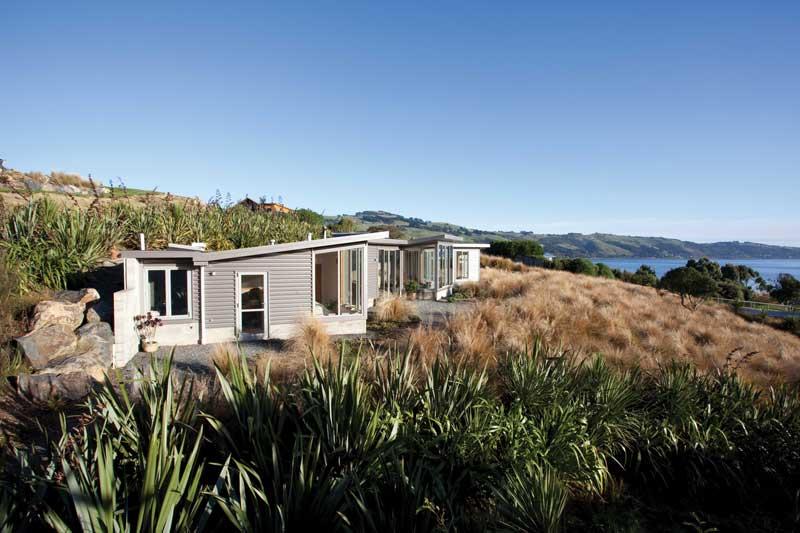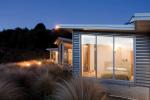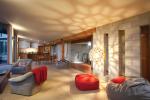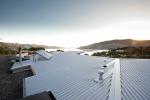Richard Wilden: house in a hill: 44

Architectural designer Richard Wilden has a fondness for the home that he conceived overlooking the Otago Harbour – and not just because
it won him an award.
As he explains, the Broad Bay home that earned an ADNZ national award in the under 250sq m category helped to push his career in another direction.
“It was the first of the more modern style of buildings that I have done,” Richard says. “Before that I had been designing straw bale and earth homes that were more rustic. I could see the limitations of specialising in this niche market and this home was an opportunity to broaden my portfolio.”
His client wanted modern looks in a passive solar house that made the most of the views down the harbour.
Richards says, “She was reasonably specific about the number of bedrooms and utilities but open to my interpretation of the site and what might fit there.” While the elevated site was large, it was also sloping which made for a small building platform. The land was also exposed to the elements and became even more so when the only tree on it – a huge macrocarpa – was chopped down.
“It was a giant of a thing but it was sick and dying,” says Richard. “And when it was cut down it opened the site right up.”
To maximise the building platform, cut and fill was used and this also enabled Richard to fulfil several objectives: by using a block wall as a retaining wall and the back wall of the house, he was able to push the house right into the slope giving more area to work with and using the soil to insulate the southern side of the house.
“We backfilled the soil as high against the block wall as we could but we had to leave a bit of space beneath the gutter,” says Richard.
Backing the house into the slope also helped it to become part of the landscape – something that Richard says would have been approved of by renowned architect Frank Lloyd Wright, as exemplified by this quote:
‘No house should ever be on a hill or on anything. It should be of the hill. Belonging to it. Hill and house should live together each the happier for the other.’
The 2.4m-high insulated block wall at the rear also gives the house thermal mass along with the insulated concrete floors
.“It’s the same principle as the earth and straw bale houses I was designing where the passive solar is all about incorporating mass in the house. With this one the mass is provided by the concrete slab and concrete block wall and that gives the house an even and consistent heat.”
And with the help of the other insulation in the house and the thermally broken double glazing, an even temperature can be maintained year-round.
“We had temperature sensors in there over autumn and winter to see the fluctuation of temperatures,” says Richard. “The key measurement was at 7am after the night time cool down and it seldom got below 15 degrees.”
Richard says his client was the one who came up with the Calder Stewart V8 profile cladding and roofing material, which she had seen used on Milton prison and liked its looks.
“It’s a strong profile; you can see it from a long way away. It has pronounced ridges that are quite close together,” says Richard. “The gunmetal fleck through it gives it an interesting colour – it changes as it reflects what the atmosphere is doing.”
While aesthetics were important, so was durability in a tough climate. “It’s quite a hostile environment. When you get the southwester blowing up the harbour you get a lot of salt spray so we needed roofing and cladding that was robust and easy to clean.”
The layout of the home has been designed to maximise the views and sunlight entering the house, the latter complicated by the fact that there was a hill to the east that blocked the early winter sun.
“We rotated the rooms around a little so they would get sun in the morning and we also offset them so that they would protrude gathering more light and to take advantage of the view down the harbour.”
The mono pitch roof slopes up from the back wall, and reaches its highest point where part of the lounge extends out from the house.
A strong linear layout has an open plan kitchen/dining/lounge area at its centre separating the master suite at the northern end, with two more bedrooms at the opposite end. This configuration allows all the living spaces and bedrooms to enjoy views and access to the outdoors. Bathrooms, laundry and utility rooms are to the south and have skylights because of the windowless retaining wall.
And the macrocarpa has not gone to waste – it features in the internal posts, beams and joinery, as well as some of the flooring and ceilings. There are also exposed concrete block walls, while the concrete floors are coloured, with expansion joints cut in symmetry with the house
Richard says the wooden elements help to give the home warmth in what is otherwise a neutral colour scheme. The hallway is defined by its macrocarpa floor and ceiling, and runs the length of the house and serves all the rooms.
“We had to rebate the concrete to accommodate the wooden floor but it was worth the effort because the transition between the two is beautiful.” The leftover macrocarpa was also put to good use, firing the wood burner with wetback that helps to boost the solar hot water.
“The house also has LED lighting so with no water heating and no space heating the power bill is really low. The first power bill was $60 and it doesn’t get much higher than that.”
By modern standards, having a separate garage is unusual but that was a deliberate design decision so the house stood on its own.
“I think that is part of the success of this house,” says Richard, “The garage is down below and you have to park and walk through a sea of tussock up the hill to the house and you see the house in a different light.”
The owner removed gorse and planted tussock around and up to the house, which has a gravel apron that morphs into the grassland, giving the home a grounded, natural feel.
All these elements help to seat the house in its environment. “I go past the house occasionally and it gets better looking all the time,” says Richard. “Now it is snugly sitting in the tussock and is part of the landscape.”



